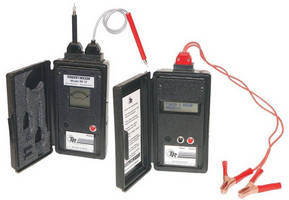RF-IT and CE-IT Insulator Testers

Model RF-IT Insulator Tester is for above ground pipeline insulators.
Model CE-IT Insulator Tester for below ground pipeline insulators.
Model RF-IT is a highly sensitive device used to test above ground pipeline insulators.
The automatic RF-IT allows the operator to pinpoint the precise contact point and emits an audible beep and when the operator gets closer to the point of contact the unit starts beeping faster. A sliding scale LCD meter moves from left to right.
The RF-IT Insulator Tester's Radio Frequency signal is applied to one side of a pipe by one of the two probes. The second probe then receives the high frequency signal. If the received signal is almost as strong as applied, the pipe is shorted.
The RF-IT has an internal band-pass filter which will filter out all the frequencies above and below 221kHz. This allows taking measurements on pipelines that are under cathodic protection or have other induced or impressed currents or signals. It is important to note that because the RF-IT uses Radio Frequency to measure the effectiveness of an insulator, the measurement results cannot be displayed in Ohms.
IMPORTANT NOTE: Do not use this instrument in an explosive environment.
The Model CE-IT Insulator Tester is fully automatic and highly sensitive electronic instrument designed to test the effectiveness of buried pipeline insulators. The CE-IT can also be used to determine isolation condition of pipelines in road crossing casings.
The Model CE-IT circuit automatically adjusts to the voltage polarity present on the underground piping system under test. A read out of the test results are displayed in English on the LCD meter. The entire testing procedure is complete in less than 30 seconds and an audible signal alerts the operator when the test cycle is completed.
Although the Model CE-IT is equipped with power start switch, the instrument will automatically shut off in 10 minutes if not in use, to conserve batteries.
The actual resistance of a buried insulator depends on many factors, such as the environment in which the joint is located. In a very low resistivity environment, the normal resistance measurement for an insulating joint may be as low as 0.5 ohm. Checking the insulating joint of a buried pipeline for current leakage is often a more reliable test than an internal resistance test. For this reason, the CE-IT looks at the electrical characteristics of the joint itself rather than the internal resistance.
CONTACT:
Sherri B Thompson, Ad Manager
954-946-9454




